Equine bone disorders
Physeal disorders
Most, but not all, bones have both a proximal and distal physis. Most of the cells in the physis are cartilage. Growth of the long bone occurs in the physis; physeal growth also adds to the width of the bone.
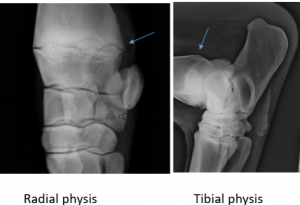
Growth plate trauma (overload) can lead to fractures but more often impacts growth. If the physis is traumatized, it doesn’t grow as well. Often the trauma is not uniformly distributed. If one side of the physis grows well but the other doesn’t, the limb grows crookedly (angular limb deformities).
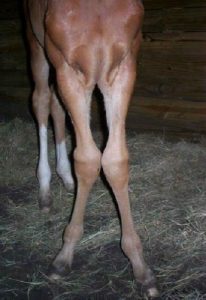
In young animals, rapid growth and exuberant exercise can be enough to damage the physis. If the physis is evenly damaged, the limb is just shorter but straight. This is rare. Generally one side of the physis is affected more than the other. The leg then deviates toward the compressed side, creating an angular limb deformity. [Note: ALDs can develop through other pathways too.]
Physitis
Physitis= inflammation of the physis.
Physitis can occur due to excessive trauma on a normal physis or to normal trauma on an abnormal physis. Causes include rapid growth due to genetics and/or diet, excessive exercise, uneven weight due to an angular limb deformity (ALD), or abnormal cartilage. If the cause is exercise or growth, the physitis is usually symmetrical. If the physitis is asymmetrical, look for ALDs.
Affected animals show signs of pain – recumbency, knuckling, shaking. The physeal area is swollen and painful on palpation.
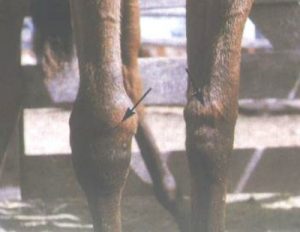
Radiographs show mixed density in the physis – a combination of sclerosis and increased lucency.
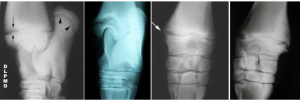
Physitis is treated with NSAIDs and removing the risk factors (decreased exercise, adjust diet, fix any angular limb deformity).
Physeal fractures
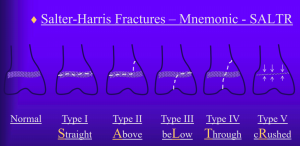
Physeal fractures are managed as in other species; most will need internal fixation for optimum healing. This is most crucial for fractures that are displaced and/or have intra-articular components. All of these are likely to impact growth and can lead to angular limb deformities.
If the fracture is not stabilized, the animal is likely to place extra weight and stress on the opposite limb, also creating physitis and angular limb deformities in that limb. The painful limb may develop flexural deformity.

